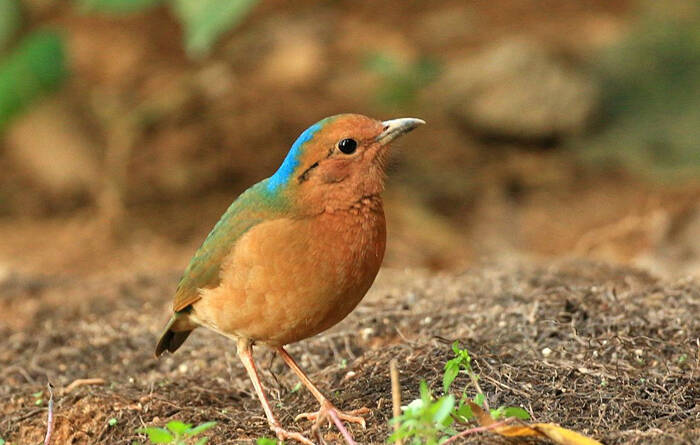Pitta nipalensis
IUCN
LCBasic Information
Scientific classification
- name:Pitta nipalensis
- Scientific Name:Pitta nipalensis,Blue-naped Pitta
- Outline:Songbird
- Family:Passeriformes Pittidae Pitt
Vital signs
- length:About 23 cm
- Weight:About 120g
- lifetime:No verification information
Feature
The male bird has bright blue top of head and nape. The female bird is similar to the male bird but the nape is tea yellow instead of blue.
Distribution and Habitat
Distributed in Bhutan, Bangladesh, Laos, mainland China, Vietnam, India, Myanmar and Nepal.
Distributed in the Indian subcontinent and southwestern China, including Bangladesh, Bhutan, China, India, Lao People's Democratic Republic, Myanmar, Nepal, Vietnam.
Habitats include subtropical or tropical swamp forests, subtropical or tropical moist lowland forests, subtropical or tropical severely degraded foreforests and subtropical or tropical moist mountain forests. They are mostly found in tropical rainforests below 700 meters above sea level and on the ground under the forest. The type locality of this species is in Nepal.
It mainly inhabits tropical forests at an altitude of 500-1000 meters, and sometimes also goes up to forest areas at an altitude of about 2000 meters. It especially likes sparse secondary forests, bamboo forests, shrubs, bamboo forest and shrub mixed forests and other habitats, and occasionally appears in abandoned farmland areas.
Appearance
The male has a brilliant blue color from the back of the head to the back of the neck, and brownish yellow on the front of the head, eyebrow, cheeks and ear feathers; the back feathers are brilliant green with brown; the tail is olive green; the wing coverts are similar to the back feathers, and the flight feathers are brown. The lower body is brown. The female's body feathers are mainly brown, and the nape to the back of the neck are dark green.
The male Blue-necked Pitta has a bright blue top and nape, and the rest of the head and neck are tea yellow, with the base of the forehead lighter, the ear feathers and the neck darker, and a black stripe behind the eye extending to the neck. The back and shoulders are grass green with slight tea yellow and brown fine lines. The waist and upper tail coverts are blue-green, the small wing coverts are grass green, and the middle coverts, large coverts and inner flight feathers are olive green with tea yellow spots. The primary coverts an
Details
Blue-naped Pitta, also known as Blue-naped Pitta, is a medium-sized bird of the Passeriformes family, with two subspecies.

Blue-necked Pittas often move alone or in pairs, mostly on the ground under the forest or among the bushes, and are more active in the early morning and evening. They often move in large leaps, and they are also very good at flying and fast. In Nepal, the Blue-naped Pitta lingers in dense forest thickets and wet ditches; in northern India, it is generally found on relatively dry ridges overlooking rivers and streams; in Myanmar, it is active in the green areas of mixed forests.
The Blue-naped Pitta mainly breeds in low mountain evergreen broad-leaved forests and bamboo forests below 100 meters above sea level. The breeding season is between April and August. It usually nests on the ground in bamboo forests, secondary forests or shrubs, and rarely in dense forests. But some nests are built on trees, with the entrance facing the tree, and only some of them can be approached. This allows the adult bird to monitor potential intruders and escape quickly in the face of danger. The nest placed on the tree is about 50 cm wide, 20 cm deep, and 9 cm in diameter at the entrance. The nest is spherical and has a relatively rough structure. It is mainly composed of twigs, bamboo leaves, grass stems and roots. The nest mouth is mostly opened near the ground, and there are usually fallen leaves or other debris to hide the nest. Each nest lays 3-7 eggs, and the white eggs are spotted with sparse purple-black, reddish brown, black-brown, purple, gray or lavender spots, and some are spotted with light red. The eggs are oval and the average size is 29 mm × 23 mm. The male and female build the nest, incubate and feed the chicks together. The incubation lasts about 17 days.
Listed in the 2012 Red List of Endangered Species of the World Conservation Union (IUCN) ver3.1-Least Concern (LC).
Listed in the second level of the "List of National Key Protected Wildlife in China".
Protect wild animals and eliminate game.
Maintaining ecological balance is everyone's responsibility!








